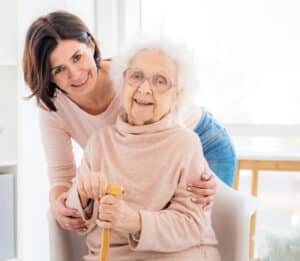The CDPAP program has given many Americans the opportunity to obtain healthcare from a loved one, rather than from a stranger. But if you’re caring for your relative at home, you need to be aware of the signs that something is wrong. Here’s how to identify the symptoms of a stroke, and how to manage the situation.

What Is a Stroke?
A stroke is a medical condition when the blood supply to part of the brain is either reduced or completely cut off. When this happens, brain cells in the affected area are unable to get oxygen and other nutrients. If blood flow is not returned within a few minutes, brain cells will begin to die.
For this reason, prompt treatment is critical. When addressed quickly, many strokes are survivable without any serious damage. The longer the stroke goes unaddressed, the more brain cells are killed, and the more severe the damage will become.
As you can see, it’s critical for home caregivers to know the signs and symptoms of a stroke. This begins with understanding who is most vulnerable to strokes.
Who Is More Likely to Have a Stroke
So, who is most likely to have a stroke?
Frankly, anyone can suffer a stroke. Children suffer strokes. Elite athletes suffer strokes. That said, some people are at more risk than others due to underlying risk factors.
The following conditions can all contribute to the risk of having a stroke:
● High blood pressure
● Tobacco use (including secondhand smoke)
● Diabetes
● High cholesterol
● Physical inactivity
● Obesity
● Carotid and other arterial disease
● Atrial fibrillation and other heart diseases
● Certain blood disorders (such as sickle cell anemia)
● Excessive alcohol ingestion
● Drug abuse (cocaine and other stimulants)
● Increasing age
● Gender (males are at higher risk)
● Race (African Americans are at higher risk)
● Family history of stroke
● Prior stroke
Keep in mind that these are just risk factors, not guarantees. A person could meet all of these criteria and never suffer a stroke. A person could meet none of these criteria, and still have one. But generally speaking, the more of these factors apply, the higher risk of a stroke.
To understand why, it helps to understand the underlying causes behind a stroke. We’ll take a look at that next.
What Causes a Stroke?
Strokes fall into two broad categories: blocked arteries and damaged blood vessels. There are also so-called “mini strokes” known as transient ischemic attacks. Here’s a quick overview of each.
A Blocked Artery
A blocked artery restricts blood flow to part of the brain, or may even cut it off altogether. Some blocked arteries are caused by cholesterol buildup inside the arteries. Over time, this narrows their diameter, eventually leading to a stroke.
Other times, strokes can be caused by a blood clot that has broken off somewhere else in the body. When these clots get to a narrow artery in the brain, they get lodged in place, and a stroke is the result.
Leaking or Bursting of a Blood Vessel
A stroke caused by a leaking or bursting blood vessel is called a hemorrhagic stroke. The exact seriousness of the stroke depends on the size of the leak and the part of the brain. However, these strokes don’t just deprive part of the brain of oxygen. They can also cause a buildup of pressure inside the skull, leading to further complications.
These strokes can be caused by many factors. The most common are high blood pressure overstressing the arteries, and defects in the arteries that have caused a weak spot.
Transient Ischemic Attack
A transient ischemic attack is similar to a full-blown stroke, but the symptoms pass on their own. This happens when blood flow to part of the brain is decreased, but returns to normal within a few minutes.
This is all useful information. But none of it’s very helpful unless you can identify the signs of a stroke. So, how do you know when someone you love is suffering from a stroke?
What Does Someone Who Is Having a Stroke Look Like?
If you want to remember stroke systems, think of the word “FAST.” This stands for Face, Arms, Speech, and Time. Here’s what that means:
● Numbness, drooping or weakness in the face is a major symptom of stroke, particularly if it’s only happening on one side.
● Arm weakness, tingling, and lack of coordination, especially on one side.
● Sudden speech difficulties, including slurring or the inability to find the right words.
● Time to call the ambulance!
That said, there are other symptoms to watch for. These include:
● Sudden confusion
● Sudden trouble seeing in one or both eyes
● Sudden trouble walking, dizziness, loss of balance, or lack of coordination
Now that we know the symptoms of a stroke, it’s time to talk about how to respond when you see one.

Treatment for a Stroke
The exact treatment for a stroke depends on the type of stroke. For you, the caregiver, the most important thing is to summon an ambulance immediately.
If the stroke was caused by a clot, doctors can provide an anti-clotting medication, which will break up the clot and restore blood flow. Other times, surgery and other invasive procedures may be required.
Regardless, time is of the essence. Let’s talk about what might happen if a stroke goes unaddressed.
Effects of a Stroke
Other than death, strokes come with a host of long-term health risks. These include:
● Paralysis or loss of muscle movement
● Difficulty swallowing or talking
● Memory loss or cognitive difficulties
● Emotional issues
● Chronic pain
● Changes in behavior
● May become more dependent
For this and other reasons, it’s wise to take plenty of measures to prevent strokes. Let’s talk about that before we wrap up.
Stroke Prevention
Here are some of the ways to prevent a stroke:
● Assess your stroke risk
● Do not smoke
● Get regular physical exercise
● Take all prescribed anti-stroke medication
● Take daily baby aspirin if risk is high
● Reduce sodium and increase potassium and eat fruits vegetables
● Maintain a healthy blood pressure
● Maintain a healthy, non-obese weight
● Take anticoagulant if prescribed
● If internal carotid artery stenosis is present, consult with physician
● Take medication for your migraines
● Get your annual flu shot
Tips for caring for someone who has had a stroke
Being a caregiver for someone who has had a stroke can be challenging. Here are some tips based on my findings:
-
Self-care is essential: As a caregiver, it’s important to take care of yourself first. You need to take breaks, eat healthily, exercise regularly and get enough sleep to keep up your strength. It’s okay to ask for help from family, friends, or neighbors when you need time for yourself.
-
Focus on emotional health: Being a caregiver can be emotionally taxing. It’s crucial to allow time for your emotional well-being.
-
Effective communication: Learning how to communicate effectively with the healthcare team is key. This can help manage the effects of the stroke and provide you with the necessary information regarding legal resources and financial support.
-
Provide practical help: Your role as a caregiver might include helping with shopping, cooking, or medication management.
-
Promote independence: While it’s important to be helpful, encouraging the stroke survivor to be independent can be beneficial for their recovery.
-
Exercise and medication: Encourage daily rehabilitation exercises and pay attention to medication side effects.
-
Consult with professionals: Meeting with rehabilitation professionals, social workers, or case managers can provide valuable insights and recommendations.
-
Make home modifications: Depending on the stroke survivor’s needs, consider making home modifications for safety and convenience.
-
Encourage participation in support groups: Support groups can provide a sense of community and understanding for stroke survivors.
Remember, each stroke survivor’s journey is unique. Patience, empathy, and flexibility will go a long way in providing the best care.
Share This Article